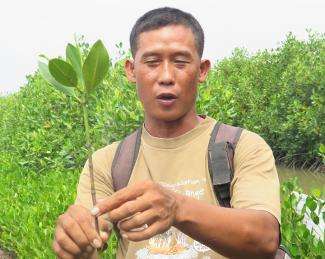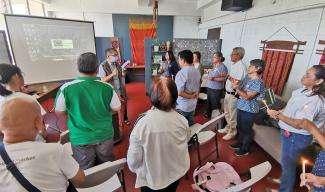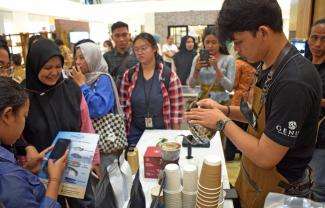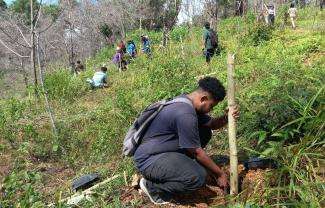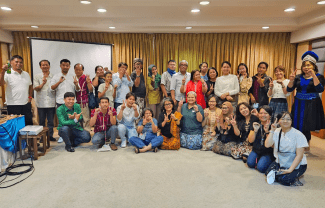The sun shine to move higher when we arrived in Banten Bay, in a series of huts who serving pecak bandeng (milkfish) original from Kasemen. Before sun to grow hot, we walked straight to the ponds and mangrove planting sites around Pulau Dua Nature Reserve, Sawah Luhur village, Serang. In there we learn to protect the coast from abrasion, while providing economic space community and the sustainability of wildlife.
Urip, Wetland International Indonesia Programme (WIIP) staff who accompanied Sawah Luhur communities, led us to the pond mangrove planting site. Ponds around the nature reserve is considered as an important location for wildlife, especially mangroves and shorebirds.
When Arrived at the location we met Udin, Sawah Luhur community that has planted various kinds of mangrove since 2009. Udin leading members totaling 30 people in the group Nature Lovers and Coastal of Pulau Dua (KPAPPD). Udin said his group has planted mangroves along WIIP over 25 acres of land belonging to the community that also functions as a pond.
Made a profit from mangroves and ponds
Residents believe mangroves can support fish farming. The proof, the fish more easily cultivated through silvo-fishery method in between the mangroves.
For the result of each two-acre pond, a period of three months, residents can harvest about 100 kilos of fish. Reached three million rupiah, depending on market prices. Residents also could still reap additional profit of approximately 60 thousand wild shrimp per day, assuming yields between 2-3 kilos.
Citizen groups also rents as a means fishing pond. The fishing pond has a six huts for shelter.
"Per person quoted USD. 30,000, as the entry fee for a full day fishing. Catch, depending on the fortunes of the fisherman, "Udin said with a chuckle.
Results of Mangrove also passable, continued Udin. He and his group seedling also sell various types of mangrove. Per rod, it costs approximately two thousand dollars only. Deliberately not sold expensive. Understandably, buyers mostly the same aim, to rehabilitate coastal areas, he added.
The former farmers, who generally have capital, using feed so well as a massive drugs made from chemicals. Practice was then ended. Due to the proliferation of pests in fish / shrimp are cultivated, said Urip. Moreover, the entry of sea water inland makes salt levels are too high for shrimp ponds and fish can live. The influx of sea water even affect residential areas are often difficult to freshwater, Urip added.
Reducing the salty lands and giving living space
Planting mangroves help to reduce levels of salt in the pond. The impact, not just the people who benefited, a variety of wild birds coming l foraging and breeding. This is what we refer to as Green Belt, said Urip. Keeping the island of piling sea water at once put a halt to sedimentation from land.
Whereas brackish land planted originally displaced residents. Udin and his group together WIIP renting the land belonging to serve as ponds and mangrove trees. The land is abandoned because their owners have a high salt content, to be used for cultivation difficult, Udin said. Due to the entry of sea water inland, an estimated 511 hectares of degraded land, Urip added.
The degraded land, leased communities along WIIP every period of 2 years, with the engagement that allowed mangrove plant for 15 years.
Yoyo, WIIP staff who came with us from Jakarta added, citizen groups with the support of institutions have also begun to calculate the carbon stocks in the pond. Yoyo forward even planning to make a profit from the environmental services.
